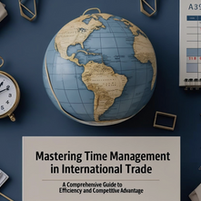Exploring Lesser-Known Payment Terms in International Trade
- Mutlu AKGÜN
- Dec 28, 2023
- 3 min read
Updated: Oct 23, 2024

Introduction
In the dynamic landscape of international trade, businesses engage in a myriad of transactions, each with its unique set of payment terms. While widely recognized methods such as letters of credit and open account terms dominate discussions, there exists a realm of lesser-known payment terms that offer diverse solutions for global commerce. This article delves into 25 less-known payment terms, shedding light on their intricacies and potential applications.
1-Cash Against Documents (CAD):
In a CAD arrangement, the buyer pays for goods upon receiving shipping documents, ensuring payment security for the seller.
2-Cash Against Goods (CAG):
With CAG, payment is made directly upon delivery, eliminating reliance on banks or intermediaries.
3-Open Account Terms with Receivables Financing:
Combining open account flexibility with receivables financing, this method provides credit to the buyer while securing financing for the seller.
4-Cash Against Acceptance (CAA):
Buyers accept a time draft, promising to pay at a specified future date, allowing them to obtain shipping documents.
5-Documents Against Payment (D/P):
Common in letter of credit transactions, D/P involves releasing documents to the buyer's bank upon payment.
6-Cash with Order (CWO):
Buyers pay in advance before shipment, providing a secure option for sellers.
7-Cash with Guaranteed Acceptance (CWGA):
Payment is made with a guaranteed acceptance, backed by a third party for added assurance.
8-Documents Against Acceptance (D/A):
Similar to D/P, D/A involves accepting a time draft with documents released upon acceptance.
9-Payment in Kind (PIK):
Goods or services are exchanged instead of traditional currency, creating a unique payment arrangement.
10-Red Clause Letter of Credit:
Allowing an advance payment before shipping, this type of letter of credit aids in covering pre-shipment expenses.
11-Forfaiting:
Exporters sell medium to long-term receivables at a discount to a forfaiter, transferring the risk of non-payment.
12-Consignment:
In a consignment setup, the seller ships goods to the buyer but retains ownership until the goods are sold.
13-Back-to-Back Letter of Credit:
Two separate letters of credit are used, facilitating intermediary trade scenarios.
14-Deferred Payment Letter of Credit:
Payment is deferred to a specified future date, providing a grace period for the buyer.
15-Silent Confirmation:
A less formal confirmation by a bank, providing assurance to the seller without the buyer's knowledge.
16-Clean Collections with Avalization:
Financial documents are presented without a title document, and a bank's guarantee is added for extra security.
17-Provisional Acceptance:
Buyers provisionally accept goods, with final payment made after inspection or acceptance.
18-Factoring:
Accounts receivable are sold to a third party at a discount, offering immediate cash flow.
19-Extended Payment Terms with Supplier Financing:
Buyers negotiate extended payment terms while sellers secure financing from a financial institution.
20-Transferable Letter of Credit with Confirmation:
The first beneficiary can transfer the credit to another party, with the confirming bank providing additional payment guarantee.
21-Non-Recourse Factoring:
The factor assumes the credit risk of the buyer, relieving the seller of repayment responsibility.
22-Bill of Exchange (BOE) Financing:
A bill of exchange is used as a financing instrument, with the seller discounting it with a bank for immediate funds.
23-Retained Acceptance:
Buyers retain acceptance until a specified condition is met, providing more control over the payment process.
24-Money Against Documents (MAD):
Similar to CAD, buyers pay against shipping documents, allowing them to take possession of the goods.
25-Joint Venture Payment Terms:
Joint ventures may involve unique payment terms based on contributions and agreements between parties.
Conclusion
These lesser-known payment terms demonstrate the vast array of options available for international trade transactions. Businesses navigating the global market should thoroughly understand and negotiate these terms to ensure a smooth and mutually beneficial transaction process tailored to their specific needs and circumstances.




















Comments